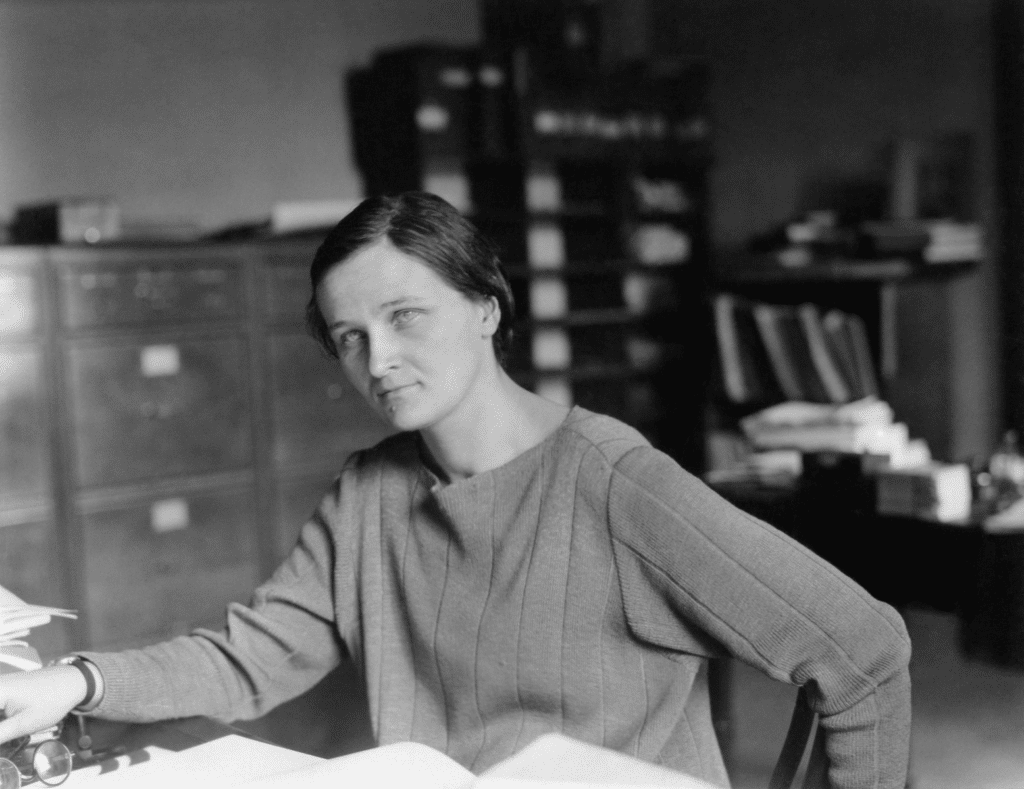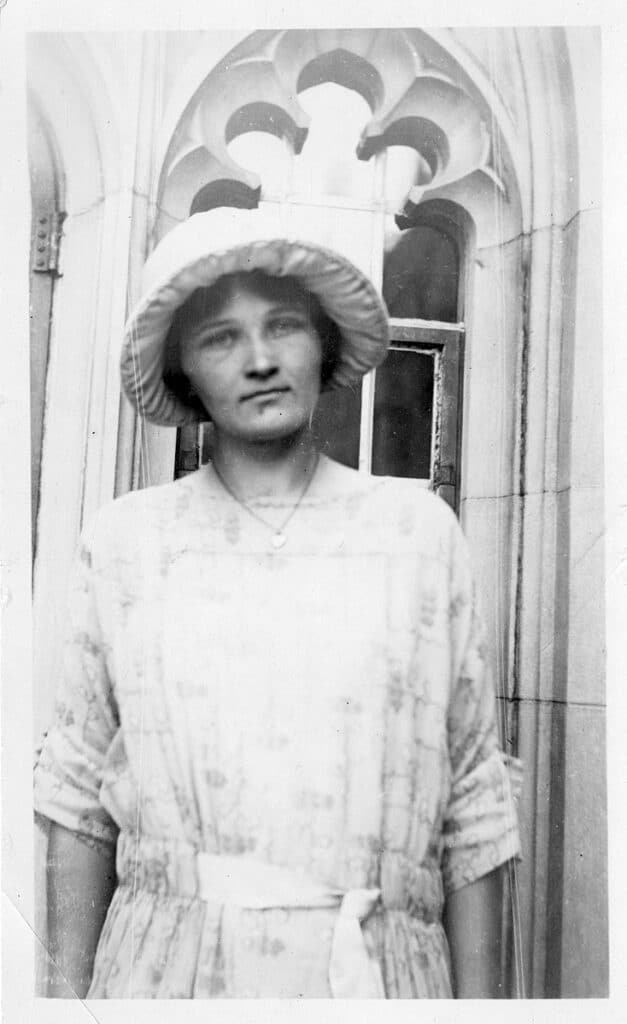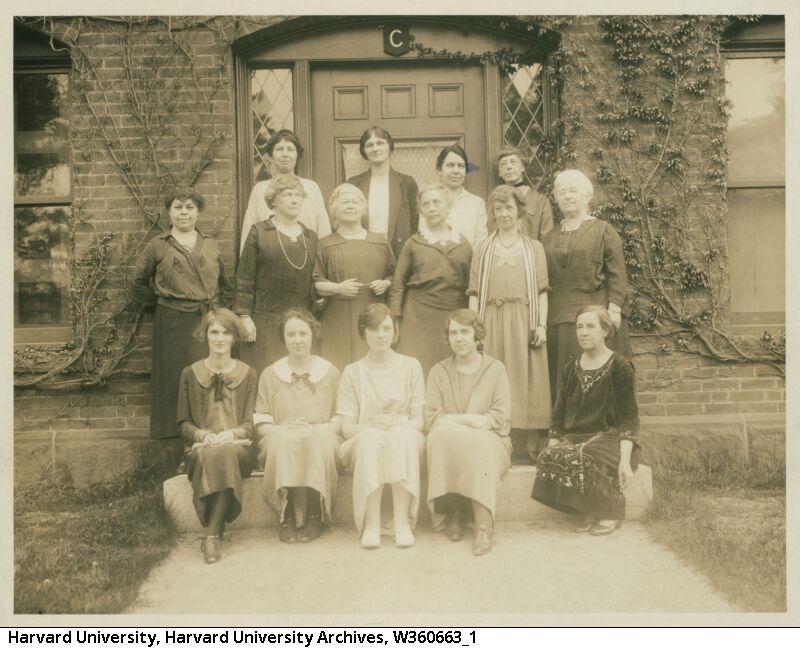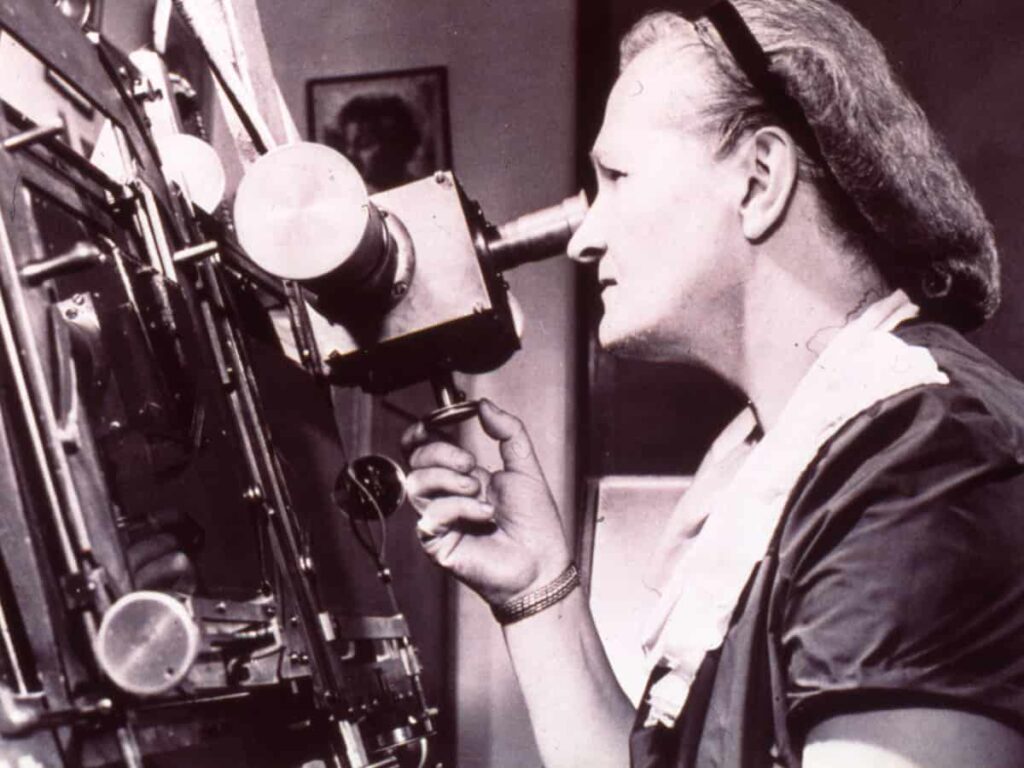By the latter half of the 1800s, the primary question among astronomers around the world was, “What are stars actually made of?”
In the 1880’s, a team of Harvard researchers believed they’d answered this question. They had created a classification system whereby stars are rated according to their surface temperature.
Using this rating system, the team determined that there is no significant compositional difference between our Sun (a star) and the Earth (an orbiting body).
That system (and belief) went unchallenged until 1925. This was when a relatively unknown British-born astronomer named Cecilia Payne presented her Ph.D. thesis
It was titled, Stellar Atmospheres. In it, she suggested that Harvard astronomers were using the wrong method of classification to determine the makeup of stars.
In her landmark thesis, Payne demonstrated how to decode the complicated spectra of starlight in order to learn the relative amounts of the chemical elements within stars. Using this approach, Payne determined that stars are composed mostly of hydrogen and helium.
And not primarily iron at the core, as was commonly believed. In short, there is, in fact, a considerable difference between the composition of our Sun and the Earth.
It wasn’t her intention, but she’d actually discovered the compositional make-up of the entire known universe.
It would take 35 years to receive full recognition for her immensely important discovery. Even after 30 years, Harvard was reticent to recognize Cecilia’s work.
In 1960, the distinguished astronomers Otto Struve and Velta Zebergs announced to the world what countless members of the scientific community already knew: “[Her] thesis was undoubtedly the most brilliant Ph.D. thesis ever written in astronomy.”

Early Life
Cecilia Helena Payne was born on May 10, 1900, in Wendover, England. Her father was Edward John Payne (a London lawyer, musician, and historian who’d been an Oxford scholar).
Her mother was Emma Leonora Helena [née Pertz]. Her mother had been a talented artist whose own mother came from an upper-class Prussian family. Some members included historian Georg Heinrich Pertz and writer James John Garth Wilkinson.
Payne had one sister, Florence (who became an accomplished pianist). And also one brother, Humfry (who became an archaeologist.)
When Payne was four years of age, her father died, forcing her mother to raise the family on her own.
Education
Payne began her education at age six. She started at a private girls’ school located across the street from her Wendover home, run by one Elizabeth Edwards.
Edwards ran her school with military-like discipline. Every day began with a hymn or patriotic song. And rather than walk anywhere, the girls were instructed to march.
Payne liked that Edwards taught her students that women are the stronger sex. She disliked that she was always singled out for writing left-handed rather than right (the correct hand).
In 1912, at the age of 12, Payne’s mother moved the family to London for the sake of her brother Humfry. He needed special classes in preparation for an independent, non-government-financed school.
There, Payne attended St Mary’s College, in Paddington. It was a large Church of England school that emphasized religion, both in teaching and in attending chapel. There was virtually no focus on mathematics or science in the first year.

Even by this age, Payne knew she wanted to study science; at that point, botany. And since her school taught creationism rather than evolution, she began reading on her own.
One of the first texts she found was a copy of Newton’s Principia; a text that should have been far beyond her interest or understanding level. Nevertheless, it captured her attention.
Published in 1687, Principia presents Newton’s three laws of motion.
- One: that a body remains in a state of rest unless forced to change by an external force impressed upon it
- Two: the change of motion (the change of velocity times the mass of the body) is proportional to the force impressed
- Three: that to every action there is an equal and opposite reaction
These laws resulted in the formulation of the law of universal gravitation. In short, the master primer in physics and mathematics.
During her second year at St Mary’s, the curriculum improved more to her liking when she was introduced to algebra and the ancient Greek mathematician Euclid. There was also an introduction to a new science teacher named Dorothy Dalglish.
Recognizing that Payne was already beyond the lessons taught to second-year students, Dalglish lent her physics books. She also took her to museums to stimulate her imagination.
Two years later, however, Dalglish became ill and left teaching. She was replaced by a mathematics teacher Payne later described as “unpleasant,” who told her she would never become a scholar.
Shortly after, Payne was effectively expelled and told to find another school.
Music or Science?
In 1918, Payne entered St Paul’s Girls’ School in the affluent neighborhood of Brook Green, in Hammersmith, London. There, she was encouraged to study science by physics professor Ivy Pendlebury, as well as music, taught by the famous composer Gustav Holst.
For a time, Payne couldn’t decide between science and music. Holst taught her to conduct and master the piano. Pendlebury taught her about electricity and magnetism, mechanical dynamics, light, thermodynamics, and astronomy.
In the end, her attraction to science won out.
Despite having just one year to prepare for the prestigious Cambridge Scholarship examination, in 1919 she was awarded the Mary Eward Scholarship for Natural Sciences. She began her university studies at Newnham College, Cambridge University, in September of that year.
She was still uncertain about which area of science to specialize in. Then Payne attended a lecture by astronomer Sir Arthur Stanley Eddington
During this, he discussed his recent trip to the island of Principe to witness the solar eclipse of May 29 (which confirmed Einstein’s theory of general relativity). By the end of the lecture, Payne had chosen astronomy as her major.
Though as yet not actually registered in the astronomy program, Eddington allowed her to use the Newnham College Observatory and conduct research in the observatory library as if she were.
Course Adjustment
In 1923, Payne received her B.A. But having no credits in astronomy, she assumed that she had no option but to become a teacher. Fortunately for the world, Eddington had another suggestion.
Eddington was certain that there were more opportunities in the US for a woman to study astronomy than in Britain. She suggested that Payne attend a lecture presented before the Royal Astronomical Society in London.
The lecture was by renowned American astronomer and Director of the Harvard College Observatory (Cambridge, Massachusetts), Harlow Shapley. He is credited with deducing that the Sun lies near the central plane of the Milky Way Galaxy, not at the center–and some 30,000 light-years away.
After the lecture, Payne spoke with Shapley about attending classes at Harvard—which started a long-distance correspondence.
In her support, Eddington wrote a letter of recommendation explaining, “[Payne] has attained a wide knowledge of physical science including astronomy, and possesses the valuable qualities of energy and enthusiasm in her work . . . I believe that she is the type of person who, given the opportunity, would devote her whole life to astronomy and she would not want to run away after a few years’ training to get married.”
That fall, Payne was granted a fellowship to Harvard College Observatory. She was only the second student to ever receive a fellowship.
Harvard
Prior to 1923, Harvard College Observatory had no graduate-level astronomy program. Therefore, Shapley started one. Payne became one of the first students accepted.
Females educated in astronomy were often hired as assistants at Harvard. Annie Cannon and Henrietta Leavitt both became internationally known for their work there. They were routinely employed to conduct scientific surveys and cataloging.
Projects such as the Henry Draper Catalogue, whereby stars were cataloged according to positions, magnitudes, and spectral types were carried out almost exclusively by females. But Shapley knew Payne was capable of making remarkable—if not break-through—discoveries.
Payne had been following the scientific work conducted in several different countries. This included Great Britain, Germany, and the US. She was interested in the application of the so-called “Saha’s equation of ionization.”
This is a mathematical expression that relates the ionization state of a gas in thermal equilibrium to temperature and pressure to “Fraunhofer lines.” These are a set of spectral absorption lines named after the German physicist Joseph von Fraunhofer.
Essentially, Payne had gravitated naturally toward the edge of contemporary knowledge.
The prospect of studying the intersection of “Saha’s Equation” and the “Fraunhofer lines” utilizing Harvard’s massive collection of spectra, enthused her so greatly. She was determined to make this the subject of her Ph.D thesis. This was the first thesis produced at Harvard College Observatory.
Although Harvard initially tried to persuade Payne to follow a more conventional line of study, Shapley actively supported her decision. He fought for her to become the first woman recipient of a Ph.D. at Harvard-Radcliffe (the women’s Liberal Arts arm of Harvard).

A New Frontier of Science
Payne was one of the first to comprehend the new science of “quantum physics.” She knew that the pattern of features in the light spectrum of any atom is determined by the configuration of its electrons.
She also knew that at high temperatures, one or more electrons are stripped from the atoms–which are then called “ions.”
Added to this known scenario, the brilliant Indian physicist M. N. Saha had recently shown how temperature and pressure in the atmosphere of a star determine the extent to which various atoms are ionized.
Having no foresight into what she was about to discover, Payne began the tedious process of measuring the “absorption lines” in stellar spectra. Within two years, she produced a thesis for her doctoral degree.
In her dissertation, Payne demonstrated that the wide variation in stellar spectra is due mainly to the different ionization states of the atoms. Hence, different surface temperatures of the stars; not different amounts of the elements.
She calculated the relative amounts of eighteen different elements. She showed that the compositions were nearly the same among the various kinds of stars.
To her surprise, she discovered that our Sun and the countless other stars are actually composed almost entirely of hydrogen and helium. These are the two lightest known elements. All the heavier elements (like those making up the bulk of the Earth), account for less than two percent of the mass of stars.
Thus, most of the mass of the visible universe is hydrogen, the lightest element. And not the heavier elements more prominent in the spectra of stars!
Since hydrogen and helium were by far the most common elements in stars, stars are considerably different in composition from the Earth and other orbiting bodies. This completely contradicted Harvard’s own position that all stars have a similar composition to our Earth.
Resistance, Disbelief, Deceit
Shapley sent a draft of Payne’s dissertation (proving that hydrogen is a million times more abundant than the metals in stars) to Princeton University’s leading astronomer, Henry Norris Russell. Upon reviewing it, he replied, “this is clearly impossible.”
Payne knew her conclusions were correct. But she conceded to the prominent astronomer’s view.
She added the following amendment to her thesis: The enormous abundances derived for those elements in the stellar atmosphere are almost certainly not real. Probably the result may be considered, for hydrogen, as another aspect of its abnormal behaviour . . . and helium . . . possibly deviates for similar reasons.
Despite the lack of universal support for her findings, in 1925, Payne received her Ph.D. from Radcliffe College for her thesis, Stellar Atmospheres: A Contribution to the Observational Study of High Temperature in the Reversing Layers of Stars. It was then published as a book.
In the interim, Professor Russell began presenting Payne’s findings at a number of scientific forums– neglecting to credit Payne.
As a result, the breakthrough discovery that stars are made primarily of hydrogen (disproving the previous prevailing view established by the Harvard team) was attributed to him alone.
Once Payne’s thesis was widely circulated, however, Russell had no choice but to admit that although he had initially rejected her thesis, she was, in fact, correct.

The Meeting of Like Minds
In 1933 (two years after becoming a US citizen) Payne traveled to Europe to meet Russian astronomer Boris Gerasimovich. He had previously worked at Harvard College Observatory and with whom she planned to co-write a book about variable stars.
While in Germany, Payne met Sergey Gaposchkin. He was a Russian astronomer who was prevented from returning to the Soviet Union because of his political views.
Though the two came from completely different backgrounds, they shared two important characteristics: a love for astronomy, and an inability to study it in their native countries.
Payne was able to find a position for Gaposchkin at Harvard. The two then decided to marry the following year. Their meeting (and subsequent marriage) resulted in one of the greatest scientific collaborations in science history.
Final Years: Acknowledgments, “Firsts,” and Honors
In 1938, Payne-Gaposchkin was given the official title “astronomer.” And shortly after, “Phillips Astronomer.”
This is a reference to the Philip’s Astronomy Encyclopedia. It was written by more than 100 leading astronomers from around the world. Each was an expert in their respective field.
She was granted this title at Harvard College Observatory. It was a position she held until 1956 when she was appointed “Professor of Astronomy” (the first female professor at Harvard).
From 1956 to 1960, Payne-Gaposchkin served as “Chair of the Department of Astronomy” at Harvard University. She became the first woman to serve as a department chair.
Payne-Gaposchkin retired in 1965 (at the age of 65) and was made “Professor Emeritus” at Harvard University, the following year. From 1967 until her death on December 7, 1979, Payne worked at the Smithsonian Astrophysical Observatory.
Just before her death, Payne privately published her autobiography, The Dyer’s Hand; later retitled, Cecilia Payne-Gaposchkin: An Autobiography and Other Recollections.
Among Payne-Gaposchkin’s many honors, in 1934 she received the “Annie Jump Cannon Prize” from the American Astronomical Society. In 1936, she was elected a member of the American Philosophical Society.
In 1943, she was elected to the American Academy of Arts and Sciences. In 1952, she was given an “Award of Merit” by Radcliffe College. In 196, she was awarded the “Rittenhouse Medal” by the Franklin Institute
And in 1976, the American Astronomical Society awarded her the “Henry Norris Russell Prize.”
Additionally, several colleges awarded her an honorary D.Sc. degree including Wilson College (1942), Smith College (1943), Western College (1951), Colby College (1958), and the Women’s Medical College of Philadelphia (1961).
Required Reading
In addition to writing numerous highly significant scientific papers during her career, between 1930 and 1957, Payne-Gaposchkin published 5 academic books—all of which are required reading in many university astrophysics departments around the world.
References
amnh.org., “Cecilia Payne and the Composition of the Stars,” Cecilia Payne: Discoverer of the Chemical Makeup of Stars | AMNH
britannica.com., “Cecilia Payne-Gaposchkin,” Cecilia Payne-Gaposchkin | British Astronomer & Harvard Professor | Britannica
mathshistory.st-andrews.ac.uk., “Cecilia Helena Payne-Gaposchkin,” Cecilia Payne-Gaposchkin (1900 – 1979) – Biography – MacTutor History of Mathematics (st-andrews.ac.uk)
scientificwomen.net., “History of Scientific Women: Cecilia PAYNE-GAPOSCHKIN,” Cecilia PAYNE-GAPOSCHKIN (scientificwomen.net)
academicoup.com., “Cecilia Payne-Gaposchkin: astronomer extraordinaire,” https://academic.oup.com/astrogeo/article/43/1/1.27/203723
wolba.ch., “Cecilia and Sergei: American Astronomers,” https://wolba.ch/gazette/cecilia-and-sergei-american-astronomers/
library.cfa.harvard.edu., “Cecilia Payne-Gaposchkin: Education and Doctoral Thesis,” https://library.cfa.harvard.edu/cecilia-payne-gaposchkin/education-and-doctoral-thesis

